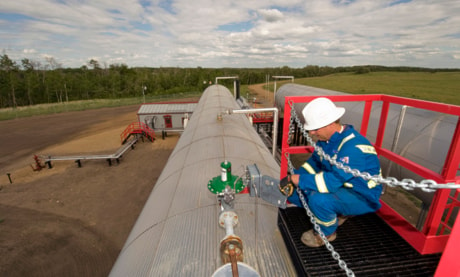EDMONTON — If a province were to be set up specifically for carbon capture and storage, it would look a lot like Alberta.
That’s a good thing, because if there’s one province that desperately needs carbon capture and storage to work, it is Alberta.
In an effort to do just that, the Alberta government announced Tuesday that seven companies will divvy up $2 billion from the province of Alberta to fund three carbon capture and storage pilot projects. The successful projects all combine capturing carbon dioxide from industrial emissions, transporting it and injecting it deep underground.
The companies selected for the funding include Epcor, Enbridge, Shell Canada, Chevron Canada, Marathon Oil Sands, Enhance Energy and Northwest Upgrading.
A spokeswoman for Enhance/Northwest says the dollar amounts for each of the projects will be subject to negotiations over the coming weeks.
But the urgency to make carbon storage and capture work is immediate.
Led by the carbon-intensive oilsands, the province is belching ever greater amounts of greenhouse gases into the atmosphere, a fact of which the world is increasingly aware.
And Alberta Environment says the solutions being tried elsewhere don’t work here.
“We don’t have those low-cost or even medium-cost reduction opportunities that a lot of jurisdictions do,” says Andy Ridge of the department’s climate change section. “Carbon capture and storage plays a critical role in what Alberta can do.”
Only 15 per cent of Alberta’s emissions come from vehicles compared with a more typical average of 25 per cent in other parts of the country. That means more efficient vehicles won’t cut carbon dioxide.
And while Alberta has one of Canada’s first wind farms, the great majority of the province’s already strained electricity supply comes from coal.
On top of that, many houses are relatively new, so retrofits won’t reduce energy consumption enough. The same goes for most of the industrial base.
About two-thirds of the province’s pledge to reduce carbon dioxide emissions by 200 million tonnes in the next 40 years is expected to come from carbon storage.
Fortunately, if pumping CO2 emissions underground to store them in perpetuity can work anywhere, it can work in Alberta.
“We think Alberta has some of the premier storage space around the world,” says Brent Lakeman, who manages the Alberta Research Council’s carbon and energy management program.
The very presence of energy deposits means the geology is favourable, Lakeman says. If the rocks were able to store oil and gas underground for millions of years, they can probably store CO2 as well.
Deep saline aquifers — another proposed CO2 repository even deeper than most oil deposits — are everywhere in the province. And Alberta’s geology is among the most stable in the country.
By 2015, the province hopes to have five or six working projects, injecting up to 10 million tonnes of CO2 a year into the ground. That sounds like a lot, but it won’t even reduce Alberta’s overall greenhouse gas emissions, which are expected to keep climbing until 2020.
Ridge defends that timetable. He says local industry would lose competitiveness if the provincial government moved faster than other jurisdictions.
Even in Alberta, CCS won’t be enough to bring greenhouse gas emissions under control.
But, perhaps more than in most places, it will be essential.
“If you don’t have this one in your toolbox, you’re in trouble,” says Lakeman.
